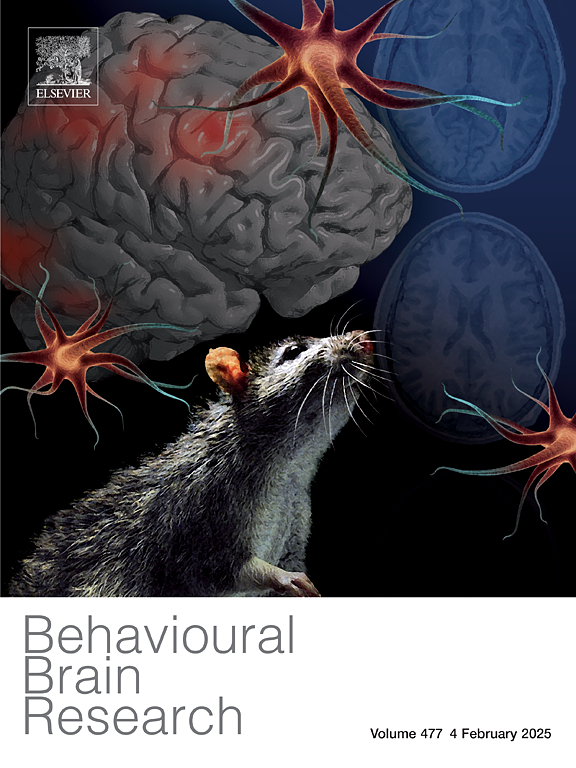Effects of anxiety induced by conditioned fear on the expression of NMDA receptors and synaptic plasticity in the rat BLA
IF 2.6
3区 心理学
Q2 BEHAVIORAL SCIENCES
引用次数: 0
Abstract
NMDA receptors (NMDAR) are vital in CNS activities such as anxiety, memory, and cognition, and the neurobiological mechanisms behind anxiety disorders are exceedingly complicated. The "glutamic acid theory" posits that glutamate excitotoxicity is a key pathophysiological mechanism in anxiety disorders. However, the exact mechanism by which conditioned fear contributes to anxiety disorders remains unknown.Based on the conditioned fear-induced anxiety disorder model, this work aims to investigate changes in NMDAR and related proteins throughout the acquisition and expression of fear memory, as well as the impact on synaptic structural and functional plasticity. Injecting the NMDA receptor endogenous agonist D-Serine (50 μg/μL) and the noncompetitive antagonist MK-801 (1 μg/μL) into the lateral ventricle of the conditioned fear model rats, as well as conducting behavioral observations, show that NMDAR are closely involved in the development of conditioned fear-induced anxiety. Model rats showed significant changes in glutamate (Glu) and γ-aminobutyric acid (GABA) levels in the amygdala (BLA), as well as expression of NMDAR and downstream BDNF/TrkB signaling pathway components. At the same time, model rats exhibited synaptic and neuronal injury, aberrant long-term potentiation (LTP), and decreased expression of essential synaptic proteins SYP and PSD-95. In conclusion, our study demonstrates that NMDAR and synaptic plasticity play a critical role in the development of conditioned fear-induced anxiety, serving as an important reference for understanding the neurobiological underpinnings of anxiety disorders and providing insights into their treatment and new possible targets.
条件恐惧诱导的焦虑对大鼠BLA内NMDA受体表达及突触可塑性的影响。
NMDA 受体(NMDAR)对焦虑、记忆和认知等中枢神经系统活动至关重要,而焦虑症背后的神经生物学机制极其复杂。谷氨酸理论 "认为,谷氨酸兴奋毒性是焦虑症的关键病理生理机制。基于条件恐惧诱发焦虑症模型,本研究旨在探讨在恐惧记忆的获得和表达过程中,NMDAR 和相关蛋白的变化,以及对突触结构和功能可塑性的影响。向条件性恐惧模型大鼠的侧脑室注射 NMDA 受体内源性激动剂 D-丝氨酸(50 μg/μL)和非竞争性拮抗剂 MK-801(1 μg/μL),并进行行为观察,结果表明 NMDAR 与条件性恐惧诱发焦虑的发展密切相关。模型大鼠杏仁核(BLA)中谷氨酸(Glu)和γ-氨基丁酸(GABA)水平以及 NMDAR 和下游 BDNF/TrkB 信号通路成分的表达均发生了显著变化。与此同时,模型大鼠表现出突触和神经元损伤、异常的长期延时(LTP)以及重要突触蛋白 SYP 和 PSD-95 的表达下降。总之,我们的研究证明了 NMDAR 和突触可塑性在条件性恐惧诱发焦虑的发展过程中起着关键作用,为了解焦虑症的神经生物学基础提供了重要参考,并为焦虑症的治疗和新的可能靶点提供了见解。
本文章由计算机程序翻译,如有差异,请以英文原文为准。
求助全文
约1分钟内获得全文
求助全文
来源期刊

Behavioural Brain Research
医学-行为科学
CiteScore
5.60
自引率
0.00%
发文量
383
审稿时长
61 days
期刊介绍:
Behavioural Brain Research is an international, interdisciplinary journal dedicated to the publication of articles in the field of behavioural neuroscience, broadly defined. Contributions from the entire range of disciplines that comprise the neurosciences, behavioural sciences or cognitive sciences are appropriate, as long as the goal is to delineate the neural mechanisms underlying behaviour. Thus, studies may range from neurophysiological, neuroanatomical, neurochemical or neuropharmacological analysis of brain-behaviour relations, including the use of molecular genetic or behavioural genetic approaches, to studies that involve the use of brain imaging techniques, to neuroethological studies. Reports of original research, of major methodological advances, or of novel conceptual approaches are all encouraged. The journal will also consider critical reviews on selected topics.
 求助内容:
求助内容: 应助结果提醒方式:
应助结果提醒方式:


